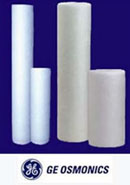About Water - Water Glossary
REVERSE OSMOSIS- A process for the removal of dissolved ions from water, in which pressure is used to force the water through a semi-permeable membrane, which will transmit the water but reject most other suspended and dissolved materials. It is called reverse osmosis because mechanical pressure is used to force the water to flow in the direction that is the reverse of natural osmosis, namely from the dilute to the concentrated solution.
SAND FILTER- A treatment device or structure for removing solid or colloidal material of a type that cannot be removed by sedimentation. Such filters can be gravity rapid-rate or enclosed pressure type.
SALT- The common name for the specific chemical compound sodium chloride (NaCl), used in the regeneration of ion exchange water softeners. In chemistry, the term is applied to a class of chemical compounds which can be formed by the neutralization of an acid with a base.
SOFTENED WATER- Any water that is treated to reduce hardness minerals to 1.0 GPG (17.1 mg/L) or less, expressed as calcium carbonate.
TOTAL DISSOLVED SOLIDS (TDS) - The total amount of mobile charged ions, including minerals, salts or metals dissolved in a give volume of water. It is measured in parts per million (ppm) or milligrams per per liter (TDS) includes inorganic elements other than the pure water molecules (H2O).
ULTRAFILTRATION- A membrane type system that removes small colloids and large molecules from solutions. Ultrafiltration removes particles in size range between 0.002 to 0.1 micron range. The process falls between reverse osmosis and microfiltration as far as the size of particles removed is concerned.
1 2 3 4 5 6 7 8

